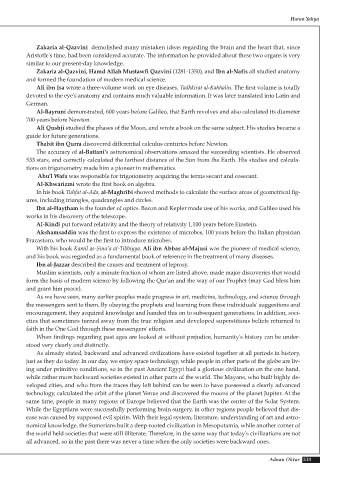Page 533 - Atlas of Creation Volume 2
P. 533
Harun Yahya
Zakaria al-Qazvini demolished many mistaken ideas regarding the brain and the heart that, since
Aristotle's time, had been considered accurate. The information he provided about these two organs is very
similar to our present-day knowledge.
Zakaria al-Qazvini, Hamd Allah Mustawfi Qazvini (1281-1350), and Ibn al-Nafis all studied anatomy
and formed the foundation of modern medical science.
Ali ibn Isa wrote a three-volume work on eye diseases, Tadhkirat al-Kahhalin. The first volume is totally
devoted to the eye's anatomy and contains much valuable information. It was later translated into Latin and
German.
Al-Bayruni demonstrated, 600 years before Galileo, that Earth revolves and also calculated its diameter
700 years before Newton.
Ali Qushji studied the phases of the Moon, and wrote a book on the same subject. His studies became a
guide for future generations.
Thabit ibn Qurra discovered differential calculus centuries before Newton.
The accuracy of al-Battani's astronomical observations amazed the succeeding scientists. He observed
533 stars, and correctly calculated the farthest distance of the Sun from the Earth. His studies and calcula-
tions on trigonometry made him a pioneer in mathematics.
Abu'l Wafa was responsible for trigonometry acquiring the terms secant and cosecant.
Al-Khwarizmi wrote the first book on algebra.
In his book Tuhfat al-Ada, al-Maghribi showed methods to calculate the surface areas of geometrical fig-
ures, including triangles, quadrangles and circles.
Ibn al-Haytham is the founder of optics. Bacon and Kepler made use of his works, and Galileo used his
works in his discovery of the telescope.
Al-Kindi put forward relativity and the theory of relativity 1,100 years before Einstein.
Akshamsaddin was the first to express the existence of microbes, 100 years before the Italian physician
Fracastoro, who would be the first to introduce microbes.
With his book Kamil as-Sina'a at-Tibbiyya, Ali ibn Abbas al-Majusi was the pioneer of medical science,
and his book was regarded as a fundamental book of reference in the treatment of many diseases.
Ibn al-Jazzar described the causes and treatment of leprosy.
Muslim scientists, only a minute fraction of whom are listed above, made major discoveries that would
form the basis of modern science by following the Qur'an and the way of our Prophet (may God bless him
and grant him peace).
As we have seen, many earlier peoples made progress in art, medicine, technology, and science through
the messengers sent to them. By obeying the prophets and learning from these individuals' suggestions and
encouragement, they acquired knowledge and handed this on to subsequent generations. In addition, soci-
eties that sometimes turned away from the true religion and developed superstitious beliefs returned to
faith in the One God through these messengers' efforts.
When findings regarding past ages are looked at without prejudice, humanity's history can be under-
stood very clearly and distinctly.
As already stated, backward and advanced civilizations have existed together at all periods in history,
just as they do today. In our day, we enjoy space technology, while people in other parts of the globe are liv-
ing under primitive conditions, so in the past Ancient Egypt had a glorious civilization on the one hand,
while rather more backward societies existed in other parts of the world. The Mayans, who built highly de-
veloped cities, and who from the traces they left behind can be seen to have possessed a clearly advanced
technology, calculated the orbit of the planet Venus and discovered the moons of the planet Jupiter. At the
same time, people in many regions of Europe believed that the Earth was the center of the Solar System.
While the Egyptians were successfully performing brain surgery, in other regions people believed that dis-
ease was caused by supposed evil spirits. With their legal system, literature, understanding of art and astro-
nomical knowledge, the Sumerians built a deep-rooted civilization in Mesopotamia, while another corner of
the world held societies that were still illiterate. Therefore, in the same way that today's civilizations are not
all advanced, so in the past there was never a time when the only societies were backward ones.
Adnan Oktar 531

